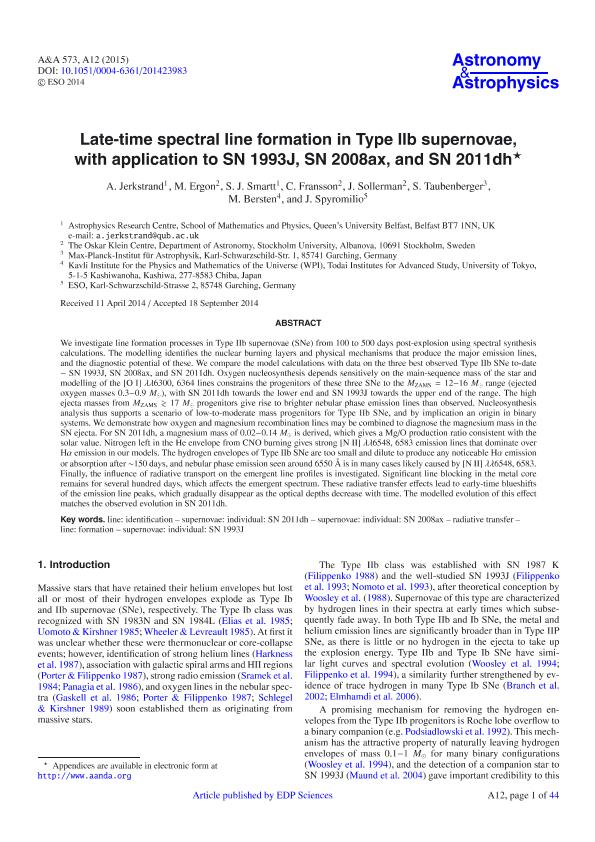Artículo
Late-time spectral line formation in Type IIb supernovae, with application to SN 1993J, SN 2008ax, and SN 2011dh
Jerkstrand, A.; Ergon, M. ; Smartt, S. J.; Fransson, C.; Sollerman, J.; Taubenberger, S.; Bersten, Melina Cecilia ; Spyromilio, J.
; Spyromilio, J.
 ; Spyromilio, J.
; Spyromilio, J.
Fecha de publicación:
01/2015
Editorial:
Edp Sciences
Revista:
Astronomy And Astrophysics
ISSN:
0004-6361
e-ISSN:
1432-0746
Idioma:
Inglés
Tipo de recurso:
Artículo publicado
Clasificación temática:
Resumen
We investigate line formation processes in Type IIb supernovae (SNe) from 100 to 500 days post-explosion using spectral synthesis calculations. The modelling identifies the nuclear burning layers and physical mechanisms that produce the major emission lines, and the diagnostic potential of these. We compare the model calculations with data on the three best observed Type IIb SNe to-date − SN 1993J, SN 2008ax, and SN 2011dh. Oxygen nucleosynthesis depends sensitively on the main-sequence mass of the star and modelling of the [O I] λλ6300, 6364 lines constrains the progenitors of these three SNe to the MZAMS = 12−16 M range (ejected oxygen masses 0.3−0.9 M), with SN 2011dh towards the lower end and SN 1993J towards the upper end of the range. The high ejecta masses from MZAMS 17 M progenitors give rise to brighter nebular phase emission lines than observed. Nucleosynthesis analysis thus supports a scenario of low-to-moderate mass progenitors for Type IIb SNe, and by implication an origin in binary systems. We demonstrate how oxygen and magnesium recombination lines may be combined to diagnose the magnesium mass in the SN ejecta. For SN 2011dh, a magnesium mass of 0.02−0.14 M is derived, which gives a Mg/O production ratio consistent with the solar value. Nitrogen left in the He envelope from CNO burning gives strong [N II] λλ6548, 6583 emission lines that dominate over Hα emission in our models. The hydrogen envelopes of Type IIb SNe are too small and dilute to produce any noticeable Hα emission or absorption after ∼150 days, and nebular phase emission seen around 6550 Å is in many cases likely caused by [N II] λλ6548, 6583. Finally, the influence of radiative transport on the emergent line profiles is investigated. Significant line blocking in the metal core remains for several hundred days, which affects the emergent spectrum. These radiative transfer effects lead to early-time blueshifts of the emission line peaks, which gradually disappear as the optical depths decrease with time. The modelled evolution of this effect matches the observed evolution in SN 2011dh.
Palabras clave:
Radiativetive Transfer
,
Sn 2008ax
,
Sn 2011dh
,
Sn 1993j
Archivos asociados
Licencia
Identificadores
Colecciones
Articulos(IALP)
Articulos de INST.DE ASTROFISICA LA PLATA
Articulos de INST.DE ASTROFISICA LA PLATA
Citación
Jerkstrand, A.; Ergon, M. ; Smartt, S. J.; Fransson, C.; Sollerman, J.; et al.; Late-time spectral line formation in Type IIb supernovae, with application to SN 1993J, SN 2008ax, and SN 2011dh; Edp Sciences; Astronomy And Astrophysics; 573; 1-2015; 1-44; A12
Compartir
Altmétricas



